Have you ever experienced being transported to a different place when you hear a specific song or a specific kind of music? Maybe you remember who you were with or where you were when you hear a old favorite. Or a song can remind you of a feeling you had or an experience you were going through when you heard it and it had touched you. There is memory in music. Music can, and often does, have a transformative effect on us. All types and kinds of music.
I think this is one of the reasons that Sacred Music, Liturgical Music is so meaningful to so many. It touches our soul. It reminds us of times shared with our families when we were young – it reminds of places we might have grown up in that we now miss. It brings up a longing. Sometimes it touches a places in our ethnic soul that we don’t even realize. A place within us that we might not even remember. But our soul remembers. That is the magic of music.
So it was on Friday evening, January 5, 2018 when Cantor Jackie Rafii brought Asher Shasho Levy, Jamie Papish and Rabbi Jay Shasho Levy to share the bimah with her for a Shabbat Service in the Sephardic tradition. The melodies, the chanting, the sounds absolutely touched my soul and transported me to an altogether different place and time. I was entranced and enriched. And from the reactions of those around me, the majority of others felt the same. A spiritual awakening of the senses.
If you go to this link: STS Live Stream Services and SELECT the Friday Night Shabbat Service 01/05/2018 you can hear the beautiful music of Cantor Jackie Rafii, Asher Shasho Levy, Jamie Papish and Rabbi Jay Shasho Levy. It was truly something special. (I’m listening as I type….aman, aman! It’s a treat!) Shomrei Torah Synagogue is blessed to have Cantor Jackie Rafii join Rabbi Richard Camras Camras and Cantor Ron Snow, all who are willing to share their bimah and always enhance our meaningful community experiences.
Aiwa!
During the service I had the opportunity to share some comments on growing up Sephardic. I want to share them with you here:
“Being Sephardic…..at the youngest age, who knew any different?
Everyone in my world was Sephardic, our families having come from the same small community in Rhodes, an island in the Mediterranean….my family, our closest circle of friends, were made up of cousins…..second cousins, third cousins….cousins of cousin’s. (We were a pretty insular group.)
We ate the same foods at our grandmother’s houses or community gatherings…..boyos, burekas, sweets like biscochos, ashuplados….We were born and grew up in America so we knew American foods, too. But for family gatherings…..keftes, avicas con arroz, fasulia….that was our ‘soul food.’
The language of our grandparents, our parents and the community was Ladino, a Judeo-Spanish that had been part of our family since living in Spain, through the expulsion in 1492, moving to the Ottoman lands, my family, as I said, to Rhodes, ….Turkish when my grandparents left, then Italian….now Greek. The Spanish became intertwined with phrases in Turkish, Hebrew and Arabic.
Ours was a strong Jewish tradition – a proud tradition. It wasn’t until I started school that I really understood that not everyone who was Jewish shared the same Jewish tradition as we did. In fact…..once I left the confines of the family, it seemed that ‘most’ of the Jews that I met ‘out there’ shared a Jewish tradition that was quite different than ours.
Growing up, it was a rare occasion when my parents and I would visit a delicatessen in Leimert Park, Newman’s, and have a bagel with lox and cream cheese. “Exotic.” I was an adult before I indulged in the ‘delicacies’ of gefilte fish, kugel or bobka! The Ashkenazi world out there….a whole different ball game. But it was the dominant expression of what was Jewish in America.
As a youngster, it was hard to know exactly where to fit in. We weren’t Yiddish, bagel and latke Jews. And although our families spoke Ladino, we didn’t fit the LATINO profile.
The 1970’s were a time of Ethnic Pride. On college campuses all over the country, people were finding their roots….Black Power, Pan African Studies, Mexican-American History…..even Jewish Studies found its way onto campuses.
And onto the scene came the American Sephardi Federation, a grassroots, groundbreaking, amalgamation of distinct, unique, Jewish, cultural communities that traced their recent roots to the Mediterranean and Levant.
The Sephardim. Finally……a place I fit in!!!!!
In 1973 we brought together the first group of young people from across the country….from communities representing Rhodes, Turkey, Greece, Morocco, Syria, Iraq, Iran, India…..all under the banner of the ASF. We met locally, nationally, internationally. They were Us.
How fun it was to gather in Atlanta, Georgia at that first Convention and meet other young people…..from New York, Atlanta, Chicago, Seattle. Maybe different regional accents….but they knew about boyos and burekas, too! …. wow!
Then we met others…..who prayed with the same Hebrew accent as we did, same melodies…..but they didn’t speak Ladino. They spoke a Judeo-Arabic.
But some of the words and phrases were similar or the same. Their families were from Morocco, Syria.
Then there were the Iraqis….some who had gone to Iran, some to Bombay. Their language was all together different….but we all prayed the same. Together….we had things in common. Our world views, not totally….but more similar. Our foods, more similar.
We came back to our homes and our cultural pride exploded. We began planning and executing programs all over the city. The Jews of Rhodes. The Jews of Morocco. The Jews of Syria. Each had a night of their cultural history, music and foods. Young adults came out of the woodwork to claim their place in their story. The general Sephardic community followed suit. It was a great cultural awakening. We held conventions up and down the coasts, groups flying from Los Angeles to Seattle. The next year we had 500 teens from across the country fly to Los Angeles to express their Sephardic pride.
Around this time, one of the local Rabbis wanted to meet with me. I finally made some time and was excited to tell him about all our successes in gathering so many young people to celebrate their cultural heritage. ‘But what about classes on Torah, and classes about Shabbat?,’ He asked. ‘No, you don’t understand,’ I told him. ‘They’re not coming for that. They’re coming to connect to their cultural heritage. To find where THEY fit in to the Jewish story. They want boyos and borekas from Rhodes. They want the sights and sounds of Aleppo. The flavors of Fez. You don’t understand, Rabbi.’ ‘No,’ he said. ‘YOU don’t understand. You can’t be Sephardic if you’re not Jewish ’.
It took me a few years to really internalize and get his message. But I got it. And he was right.
There’s more to our heritage than just our cultural traditions….. and truthfully. That goes for all of us, whatever our cultural background
######
So let’s jump ahead a few years…..here we are. We’ve grown past our college years. Many of us have married. Some…..well, some, like myself, a Sephardia, married, an Ashkenazi ….(it happens) an INTERMARRIAGE!
We have two boys, Askefards, we call them. The best of both traditions.
Traditions.
Traditions might vary.
But we all follow the same Torah.
When it came time to look for a neighborhood synagogue, one our children could grow up in – and learn the basics of Judaism – CBK became the obvious choice for us in the West Valley. CBK morphed into STS. And it became our home. Our family has grown up here at Shomrei Torah Synagogue. And our family, while holding tight to many Sephardic traditions during holidays and life cycle events, has incorporated many new traditions that we’ve learned from our STS family and friends.
We live, what we like to call, a new American Judaism….
The best of our cultural traditions, rich and textured as they are, sprinkled with traditions of the place where we live. Within the framework of the Torah – which we all share.”
#####
The service was followed by lovely Shabbat dinner and delicious Sephardic desserts enjoyed by 225 guests, who lingered and enjoyed each others company. The desserts were lovingly gifted and prepared by a group of volunteers, led by master baker Kaye Israel. The bakers included Marilyn Conrad, Sharlene Blau, Judy Yaniv Goldberg, Sandi Gilbert, Cantor Jackie Raffi, Maxine Schwartz, me (Marcia Weingarten) and the invaluable help and support of Sue Moss. Pictures of the desserts and the recipes are included:
Recipes for Desserts Prepared for Sephardic Shabbat at Shomrei Torah Synagogue January 5, 2018
BISCOCHOS
Biscochos de Huevo
Biscochos are often called tea biscuits. We think of them as a “biscotti”, a crunchy treat! Biscochos are a bit sweet and are wonderful with your morning coffee (could be afternoon or evening coffee or tea or even milk, for that matter!!)
Ingredients for My Mom’s Biscochos
1 C eggs
1 C sugar
3/4 C oil
3 tsp baking powder
1 tsp vanilla flavoring
5 – 7 C flour
Topping:
1 egg + 1 drop of water, beaten well
sesame seeds
(alternative to sesame seeds: cinnamon and sugar or “sprinkles”)
These are my mom’s directions:
With electric mixer, beat eggs and oil in a mixing bowl. Add sugar and vanilla and continue to beat until well blended. Add flour and baking powder gradually, knead into a medium dough until no longer sticky.

Place onto floured work area and finish kneading dough with additional flour as needed. Dough should not be sticky as long as you can handle it without it sticking to your hands.

Take walnut-sized pieces and roll down on table with palms of hands into a rope 5 inches long and only 1/2 inch thick.

Press down with fingers to create channel;

Fold rope over and cut slits into the edge.

Join into a bracelet shape. Brush egg on top side.
Dip top side into chosen topping ( sesame, cinnamon sugar or sprinkles):

Place on cookie sheet lined with parchment paper. Bake in preheated 350 degree oven for 12 minutes or until lightly brown. Remove from pan. Allow to cool.

BAKLAVA
Baklava is a sweet pastry made of layers of Filo dough filled with chopped nuts and bathed in a sweet syrup. It is labeled as a Turkish, Greek or any of a variety of Middle Eastern delicacy. Our families made it on the Island of Rhodes, so we claim it as our own.
There are many variation in making Baklava. Different communities feature different nut mixtures and dIfferent configurations when baking. My mom makes a rolled variety. Here is her recipe:
Kaye Hasson Israel makes Baklava
ingredients:
1 Lb prepared FIlo Dough
5 Cups almonds, ground (or other nuts of your choosing)
1 C Sugar
1/2 tsp ground Cinnamon
1 tsp ground cloves
1 C oil in a small bowl.
1/2 C Tasted Sesame Seeds (optional)
Prepare a mixture using ground nuts, sugar, cinnamon and gloves. Set aside.
Open package of Filo. Keep moist and usable by placing a moist cloth over the waxed paper covered batch of Filo that you are not currently using ( otherwise, Filo has a tendency to dry out).
Place one layer of Filo on your work surface. Brush with oil. Place a second layer of Filo directly on top. Brush second layer with oil.
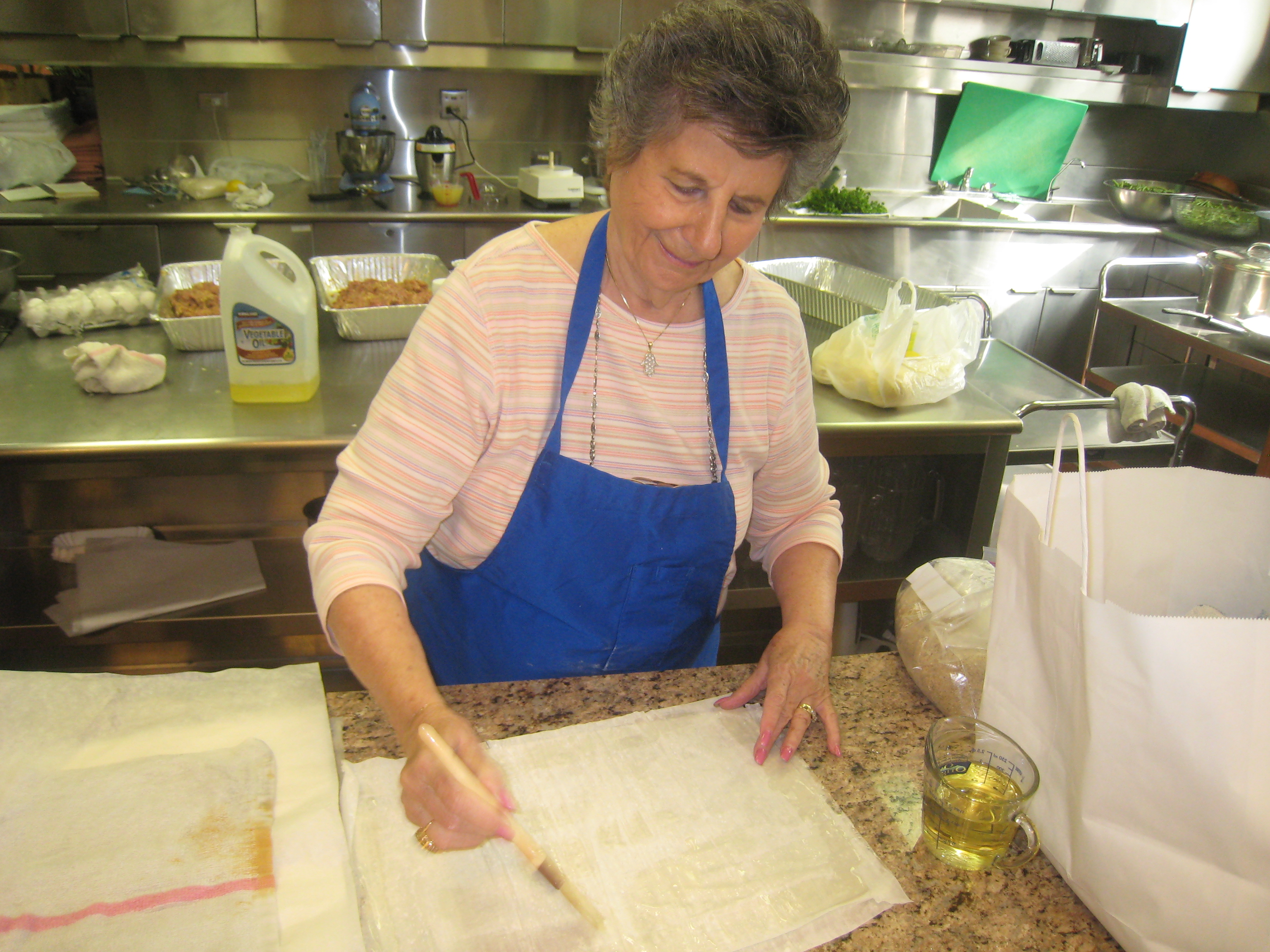
Sprinkle nut mixture in a thin, even layer on brushed Filo. Top with one additional sheet of Filo. Brush with oil.

Begin to roll Filo tightly. Slice rolled Filo log at a diagonal. Cut approximately 1 inch in length. Place cut pieces on a cookie sheet, lined with parchment paper.
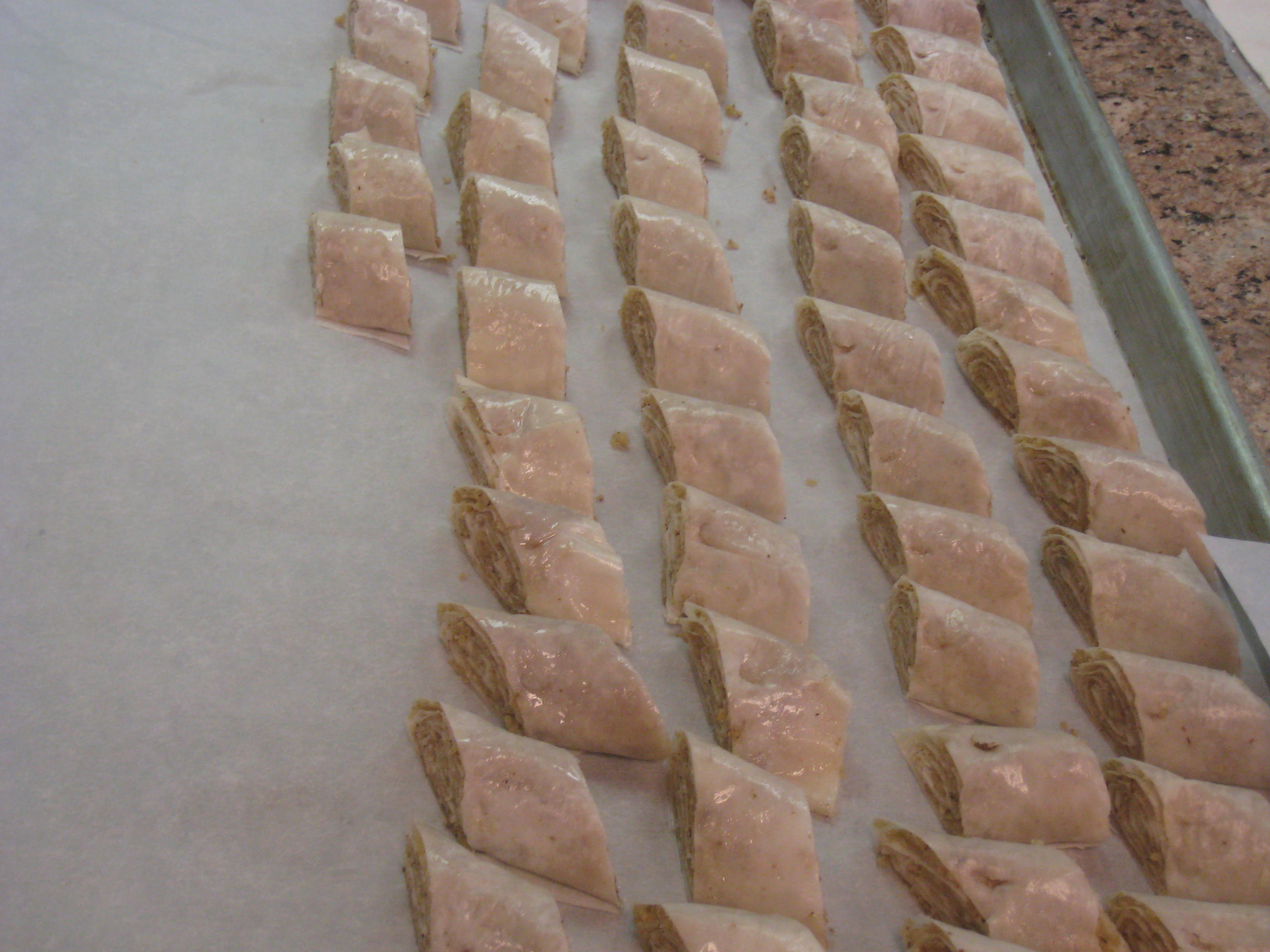
Bake in a 350 degree oven for approximately 20 minutes (Since ovens vary, watch as it bakes…when it begins to take on color, you can remove from the oven)
Allow to cool.
In the meantime, prepare syrup.
Syrup ingredients:
1 1/2 C Honey
1 1/2 C Sugar
1 C Water
Combine all ingredients. Boil on stove. Cook until it becomes “sticky” (if you have a cooled bit between your fingers, it should form “strings”)
When syrup is ready, pour over tray of baked Baklava. Allow syrup to soak in.

For serving, “soaked” piece of Baklava can be placed in size-to-fit paper Bake Cups (often called Cupcake liners) and placed on a serving platter.
Divine!!!!!
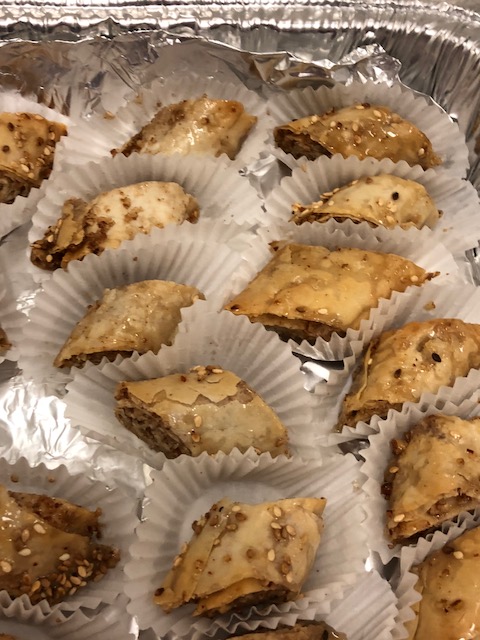
MAROCHINOS

Marochinos are an almond macaroon type of cookie. They are an excellent parev dessert for any time of the year, and a favorite for Passover. Make a batch and enjoy them!!
Ingredients:
2 C blanched almonds
1 C sugar
2 eggs…whites only
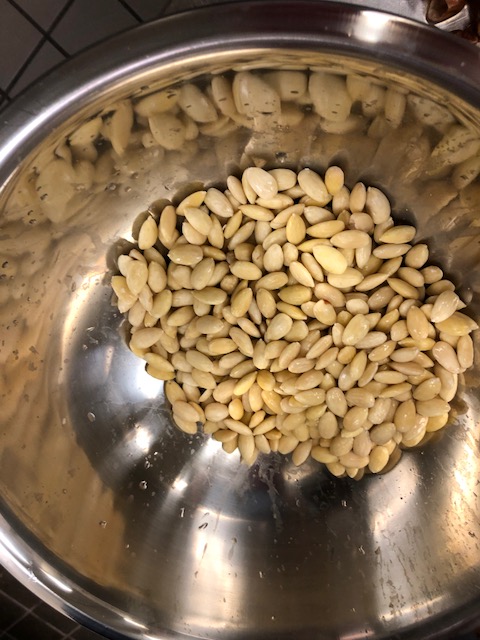
Grind blanched almonds to near a fine consistancy. Mix in a bowl with sugar.
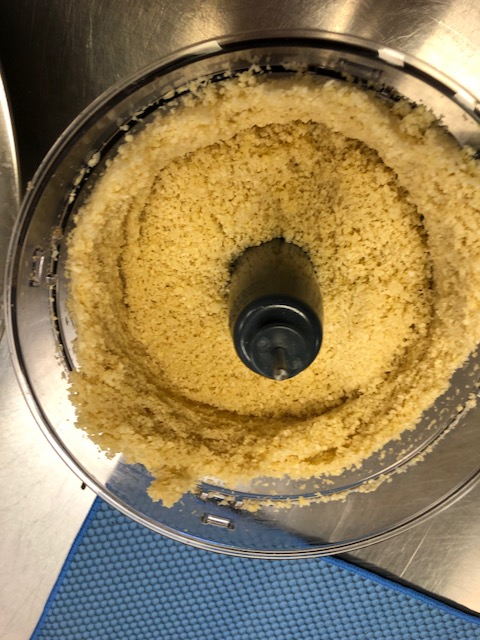
Add egg whites and add almonds and sugar. (do NOT beat egg whites prior to adding. This will flatten the cookies during baking) Mix until biscuit-dough consistency. Using a tablespoon or metal scoop, drop 1″ apart on cookie sheet lined with parchment paper. Bake for 10 minutes in a pre-heated 350 degree oven.
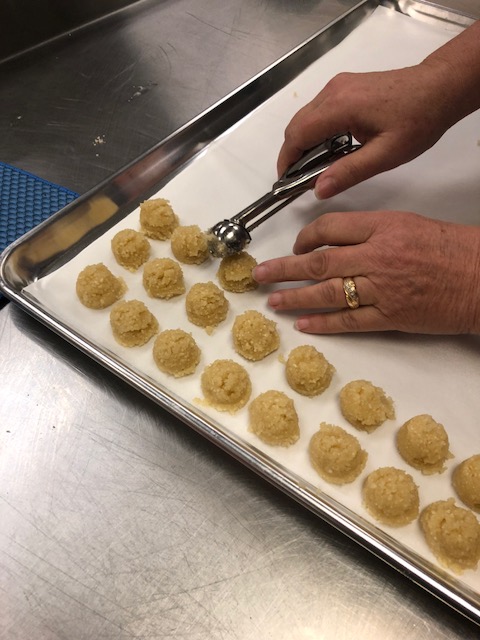
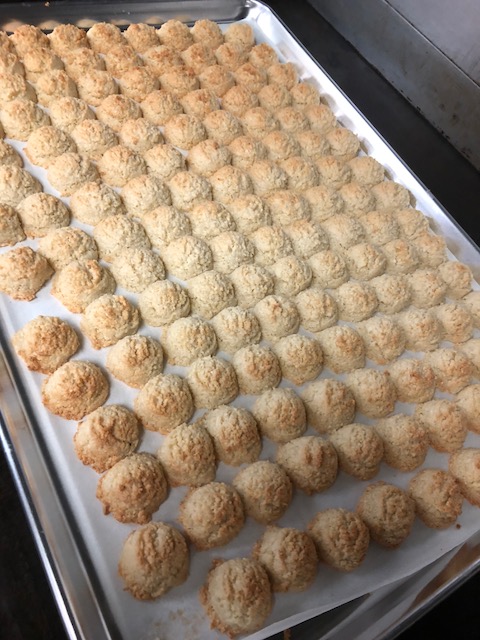
Allow to cool completely before handling. Will harden as they cool.

ASHUPLADOS
 Growing up, we knew it was a very special occasion when Grandma made Ashuplados……meringue clouds! Sweet….light as a feather, a light shell on the outside. Texture, sweetness……simply….divine!!! They look beautiful on a sweet table, and delight young and more mature and sophisticated palettes alike! These are one of my mom’s signature delicacies. Give them a try! And let us know how they turn out!! (They are great to add to your Passover collection!)
Growing up, we knew it was a very special occasion when Grandma made Ashuplados……meringue clouds! Sweet….light as a feather, a light shell on the outside. Texture, sweetness……simply….divine!!! They look beautiful on a sweet table, and delight young and more mature and sophisticated palettes alike! These are one of my mom’s signature delicacies. Give them a try! And let us know how they turn out!! (They are great to add to your Passover collection!)
Kaye (Hasson) Israel’s Ashuplados
Ingredients:
1 ¾ Cup sugar
6 eggs – (you will use the whites ONLY)
Preheat oven to 400 degrees.
Separate eggs. Use whites ONLY.
Place in a COMPLETELY dry mixing bowl. (moisture will adversely affect the creating of the meringue).
Using an electric stand mixer, begin mixing the egg whites and gradually add the sugar. Continuing beating on high for approximately 20 minutes. Mixing will be done when the mixture stands in very stiff peaks.
Line two baking sheets with parchment paper. ( there was a time when brown paper bags were cut and used to line these pans to ensure a very dry surface. However, parchment seems a more sanitary alternative available these days!!
Spoon mounds of the meringue onto the lined cookie sheets.
Ashuplados can be made as large or small as you wish.
My mom used heaping tablespoons to create these clouds.
We sprinkle nonpareils on top for a festive look.
Before putting them in the oven, TURN HEAT DOWN to 225 degrees.
Bake for one hour.
Ashuplados can be made one day before serving. They are best enjoyed for a day or two after preparation. By the third or fourth day they become dry and are not as good as when first prepared.
(* however, we have learned over the past few years that ashuplados freeze beautifully! Package delicately and freeze within the first day they are made).
Yield: approximately 48 ashuplados

MUSTACHUDOS
In our home, we have always used a variety of nuts in baking. (Moustachudos are the cookies that were sprinkled with powdered sugar). The cloves give them a special “kick”. These treats can be made in advance and freeze well. (Another one that can be added to your Passover collection).
Ingredients for Moustachudos:
1 1/2 C pecans or walnuts, coarsely ground
1 1/2 C almonds, coarsely ground
3/4 C sugar
1/2 tsp cinnamon
1/2 tsp ground cloves
1 egg
water – 1/2 eggshell full
Coarsely grind all nuts.


Add other ingredients including 1/2 eggshell filled with water. (folks, that’s how it’s done!!)
Shape into triangle or ball shapes about 1″ in diameter.

Place on cookie sheet lined with parchment paper. Bake for 5 or 10 minutes in a 400 degree oven until lightly brown.
 Allow to cool and harden before removing from pan. Sprinkle with confectioners’ (powered) sugar.
Allow to cool and harden before removing from pan. Sprinkle with confectioners’ (powered) sugar.
It was a joyfully wonderful Shabbat experience. The music was soul stirring! The Sephardic delicacies were a delight to share. Shomrei Torah Synagogue in West Hills, CA is a wonderful community. If you are ever in the area, we invite you to visit, If you live in the are, come by. We would love to have you join us. Visit us at http://www.stsonline.org.
As always, Bendichas Manos. May your hands always be blessed.






